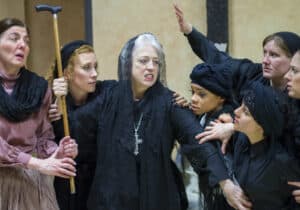Cruella in a Mantilla?: Bernarda Alba at FPCT Needs Some Rethinking

Margaret Condon, Melissa McGinley, Helenmary Ball, Linae Bullock, Ren Pepitone, Kate Bailey Metkus, and Amy Mulvihill
Posted on BroadwayWorld.com April 21, 2015
Only a brave community theater would take on The House of Bernarda Alba, Federico García Lorca’s last play. Written by a closeted gay playwright at the very outset of the Francisco Franco’s conservative fascist rule and savagely attacking that era’s repression of female freedom, both social and sexual (and by implication other freedoms), it inevitably betrays an air of extreme avant-gardeism. Ibsen and Strindberg and Wedekind may have gone into the same territory, but as of 1936 not too many others. And Lorca drives home his message as if no one had ever conveyed it before – which was more or less true in his time and place.
It’s different now. Today, in much of the world, including this corner of it, be the realities what they may, in the realm of theory and discussion the cause of women’s freedom is not nearly as controversial as it was, and plays about it are likely to be neither as shocking nor as trailblazing. The Vagina Monologues is the new normal. And that means that Bernarda Alba must be presented, to some degree, as a period piece. If you present it without that distance, without indicating that you know that what once needed to be shouted can now be said in a more moderate voice, the performance will grate on the ear and the mind. And that is the central problem with the revival of Lorca’s play at Fells Point Corner Theatre, a company whose productions ordinarily make me forget the community theater label. The necessary distance seems to require professional resources.
The problem begins with the depiction of Bernarda herself. Bernarda (Helenmary Ball, directed by Richard Barber), for all the wrong she perpetrates, should not be portrayed as a villain. In trying to immure her five daughters within a house of mourning for eight years, she is trying to preserve values of respectability and chastity in which she truly believes. Ball and Barber seem bent upon making her out to be a model of malignity. She seems to hate her daughters, and her hatred is presented as her motivation. Her assertions to her maid, La Poncia (Margaret Condon), that she has the whole situation under control sound a lot like the clichéd bwa-ha-ha of the archetypal melodramatic villain who mistakenly thinks the heroine is securely tied to the railroad tracks, instead of the utterances of a soul who, unawares, is completely out of her depth. She would be far more chilling and far more believable played at a softer pitch.
The difficulties go on with La Poncia, probably the second-most important character in the play. And here the problems start with Lorca’s script, which cannot quite work out La Poncia’s attitude toward Bernarda. The senior servitor in the house, she starts out the play claiming to hate her employer, but she spends so much time trying to warn Bernarda of her folly, and so much time acting as a sort of Greek chorus that these professions of hatred ring hollow – or at least would in a part intended to be coherently written. Condon (perhaps prompted by director Barber) tries to bury the contradictions in a devil-may-care, often jocular, above-the-fray delivery that take her out of the atmosphere of the play altogether, and doesn’t work at all when Bernarda is portrayed as such an unregenerate villain. If La Poncia doesn’t really hate this Bernarda, she ought to. She ought to be far more involved in opposing the victimization of the five young women, and far more opposed to Bernarda than she seems.
Then too I cannot see what benefit the change of setting to what the program describes as an 18th century Caribbean island brings. It does establish some excuse for one or two bits of obeah voodoo ritual, but the significance of that escapes me. Perhaps dramaturg and adapter Kate Bishop was thinking of other stories of female captivity and oppression from that time and/or place, a la Jean Rhys’s Wide Sargasso Sea, but, if that is the notion, very little in the text, the costuming, or the scenery supports it. The exquisite costumes (by Helenmary Ball wearing a different hat, or should I say mantilla) are a treat for the eye, filled with black lace or, near the end, white lace) and the spare but evocative setting (by Trudi D. Ludwig), seem far more Spanish than Caribbean. Bishop’s production notes cite, apparently as precedent, recent performances where the setting has been changed, but those changes seem less fanciful and more legitimate. She mentions one rendering which transposes the setting to modern Iran, for instance (London 2012), and the oppression of women in many contemporary Islamic societies does come across as a parallel to the treatment of women in ultramontane Fascist Spain. But I can see little potentially comparable in this setting, and nothing actually made visible.
The part of the play that seems more successfully rendered is the story of the five daughters, three of whom are involved in a love quadrangle with a man never seen onstage but powerfully felt, Pepe el Romano. Those three, Adela, the youngest and prettiest (Linaé Bullock), whom Pepe actually is sleeping with, Angustias (Melissa McGinley), the oldest and plainest, whom Pepe is courting for her money, and Martirio (Ren Pepitone), whose passion for her sister Adela Pepe is threatening, are all well-portrayed. And their intertwined stories plausibly justify the passion and the histrionics (in the literal, not the derogatory sense of the word) they bring forth. In particular Adela’s outburst of carnal high spirits and passion toward the end is powerful, and its doomed conclusion suitably tragic.
In short, this is a flawed production of a flawed masterpiece. And perhaps, in fairness, the flaws were unfairly heightened by opening-night jitters when I saw it, with lots of blown lines that had to be repeated, and a failure of the air conditioning which left the audience coping with the same kind of sultry heat the characters complain of. I would expect the execution of these details to improve as the run goes on, and perhaps the equilibrium of the piece will assert itself against the directorial errors as well.
In the end, Lorca’s rebellion against an ethos which says no to so much human feeling and sexual passion, which gives such veto power to unthinking conventionality and religious diktat, states a timeless theme. That does not mean that every aspect of Lorca’s articulation of that rebelliousness is equally timeless He may have had one foot in Brechtian agitprop, according to the conventions of which Bernarda could be a two-dimensional villain, Cruella de Vil in a mantilla. That dated kind of oversimplification is the most important thing a modern production must rescue Lorca and the play from. Bernarda too is a victim, whether Lorca fully understood it or not himself, and a production which consistently makes Bernarda’s own victimhood clear, not just in the fadeout at the end of the play but throughout, would be stronger than this one. That said, there is a lot to like in this production, particularly with the younger portion of the dramatis personae and the cast. It is still worth taking the time to see.
Photo credit: Nat Raum
Copyright (c) Jack L. B. Gohn, except for production photo

 I lived in London and Vienna before coming to the United States, and grew up mainly in Ann Arbor. I was writing plays and stories as early as grade school. My undergraduate years at the University of Pennsylvania, where I first reviewed theater, for the college paper, were succeeded by graduate study at the Johns Hopkins University, where I earned a doctorate in English Literature.
I lived in London and Vienna before coming to the United States, and grew up mainly in Ann Arbor. I was writing plays and stories as early as grade school. My undergraduate years at the University of Pennsylvania, where I first reviewed theater, for the college paper, were succeeded by graduate study at the Johns Hopkins University, where I earned a doctorate in English Literature.